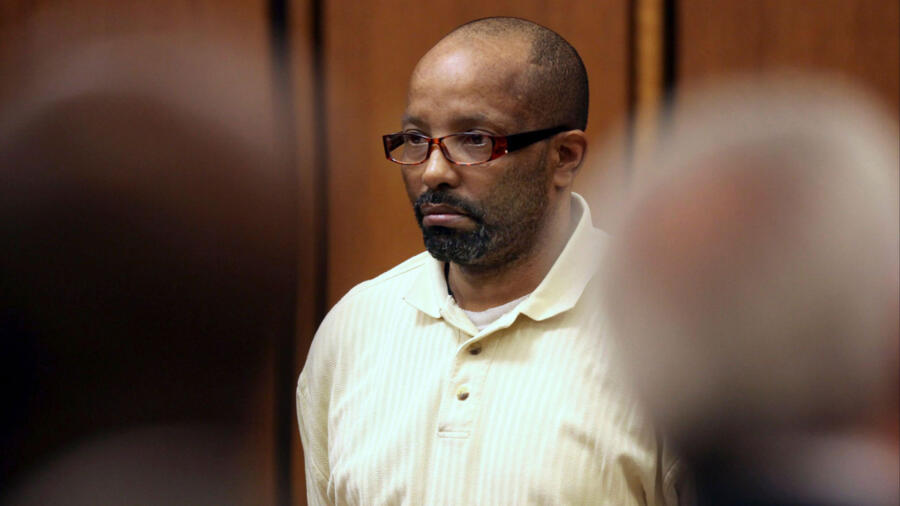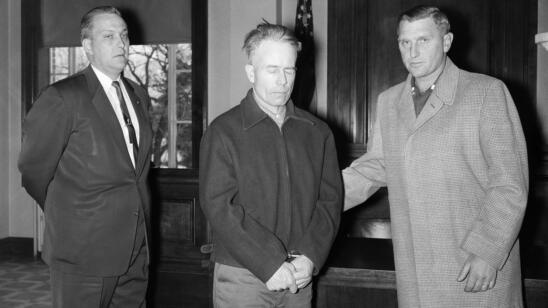Warning: The following contains disturbing descriptions of violence, including sexual violence. Reader discretion is advised.
Inside Anthony Sowell’s “house of horrors” in Cleveland, Ohio, police discovered a gruesome scene.
Between 2007 and 2009, Sowell, a former U.S. Marine and convicted sex offender who served 15 years for kidnapping, rape and attempted rape, murdered 11 women. He hid or buried their remains in his home and yard. Among the findings was a skull, which he had wrapped in a paper bag and placed in a bucket. The odor permeating from Sowell’s house was said to be so overwhelming that people thought it came from a nearby sausage shop.
After raping them, Sowell killed most of his victims by manual strangulation, earning him the nickname “The Cleveland Strangler.” He lured his victims, all Black women, to his house with promises of drugs and alcohol. On October 31, 2009, police apprehended 50-year-old Sowell after one woman, Vanessa Gay, survived a violent encounter with him.
Authorities were accused of a slow response to the case, which was exacerbated by the fact that some of Sowell’s victims were never reported missing. For others, families could not get police to open up cases because their loved ones struggled with mental health issues and addiction.
“Many of the families went to the police, and the police wouldn’t even take a report,” Rachel Dissell, a former investigative reporter who covered the Sowell case for The Plain Dealer, tells A&E True Crime. “Police would tell them that if they’re using drugs, they’ll come back when they’re ready.”
When police did take a report, Dissell says, the families had to be persistent. The families also blamed the media for their lack of coverage of their missing family members.
A&E True Crime takes a closer look at Sowell’s victims.
Crystal Dozier
Crystal Dozier, a 38-year-old mother of seven, went missing in May 2007. In a 2011 interview, Dozier’s mother described her daughter as “the responsible child” and her “little mother hen.” Unfortunately, after one of Dozier’s children died, she struggled with drug addiction, which Sowell likely preyed upon. Because she had previously gone missing, Dozier’s family accused the police of failing to investigate and launched their own campaign to find her.
In 2009, police discovered her remains next to a fence in Sowell’s backyard.
Tishana Culver
Thirty-three-year-old mother Tishana Culver spent several years without stable housingbefore rebuilding her life and moving into a small apartment in the Woodlands Hill Park area of Cleveland. Her family recalls her acts of kindness, including bringing plates of food to those living in their vehicles. But, like many of Sowell’s victims, Culver struggled with drugs and drifted in and out of her family’s lives.
“People who are predators, serial rapists and serial killers, don’t go after folks who they think people care about, because then they will get caught,” says Dissell. “They go after folks who they believe or assume people won’t miss or don’t care about.”
Culver disappeared in 2008, and her family feared the worst when they learned of Sowell’s murders. On November 25, 2009, the Cuyahoga County coroner’s office identified Culver’s remains.
Leshanda Long
Leshanda Long, a mother of three, was last seen in August 2008. An aunt called Long “strong willed and sassy” in an interview, but drugs became a prominent part of her niece’s life. Long was only 24 at the time of her death and the youngest of Sowell’s victims. Authorities only recovered her skull at the scene. The rest of her body remains missing.
Michelle Mason
Michelle Mason left Cleveland as a young adult to spend time in New York and New Jersey. When her family didn’t hear from her, they filed a missing persons report. After, Mason occasionally checked in with them. Battling a drug addiction, she returned to Cleveland and attempted to turn her life around.
In October 2008, Mason went missing again. Her family reported her disappearance to local police, but grew frustrated by their slow response and the lack of media coverage.
Mason’s remains were eventually found at Sowell’s residence. “After they started unearthing bodies, the media began interviewing some of the families. There was one family member who was very upset,” Dissell recalls. “She said there were news outlets running a story about Christmas ornaments being stolen from someone’s front yard, but they refused to run a story about a mother who was missing.”
Mason’s family noted that up until she went missing “her final years were full of happiness and personal peace.”
Kim Smith
Despite struggling with drugs, Kim Smith took meticulous care of her disabled father, making sure he got to his doctor appointments and cooking and cleaning for him. Friends, who last saw Smith on January 29, 2009, three days before her 44th birthday, described her as an “artsy person,” who enjoyed singing. She was not reported missing until after the bodies were discovered in Sowell’s home.
Nancy Cobbs
After spiraling into a world of drugs, Nancy Cobbs ended up spending time in prison. Later, believing she hadn’t been the best mother, Cobbs devoted herself to her five grandchildren. At some point, she befriended Sowell, who lived in the same neighborhood. The family knew of him but didn’t consider him dangerous.
Cobbs, 44, vanished in April of 2009. The family filed a missing persons report, searched abandoned buildings and posted flyers. Six months later, her body was found in Sowell’s home.
Amelda ‘Amy’ Hunter
Amelda “Amy” Hunter, a beautician and mother of three, disappeared in the spring of 2009. Hunter’s sister described her as a “fighter.” Her family remembers her as an avid bookworm who loved the classics. Like other victims, 47-year-old Hunter also struggled with a drug addiction. She was not reported missing until police first discovered bodies at Sowell’s house.
Tonia Carmichael
According to friends and family, Tonia Carmichael loved life and, for a time, worked hard to provide for her two daughters. She was employed as a medical secretary and bartender, and also earned her barber and real estate licenses. In 1985, Carmichael gave birth to a third child, a son. Soon after, she became addicted to drugs.
Carmichael, 53, disappeared in the fall of 2009 and was the first victim identified from Sowell’s home.
Janice Webb
People remember Janice Webb as the “family jokester,” who enjoyed pulling pranks. But in 1995, after a trip to Los Angeles, her life took a dark turn. She began using drugs and spent time in and out of jail for various crimes. Even as she battled her addiction, according to a sister, she was the one who kept the family together. Forty-eight-year-old Webb disappeared on June 3, 2009. Her family reported her missing about a month later. Investigators found Webb’s body inside Sowell’s home.
Telacia Fortson
Telacia Fortson was adopted as a child and, although she was loved, according to friends, she never overcame her feelings of abandonment. She often ran away from home as a teenager. Around this time, she became addicted to drugs and was arrested multiple times. She had three children, but lost custody because of her addiction. In early June 2009, just as she was turning her life around, 31-year-old Fortson vanished. Her adoptive mother reported her missing. Fortson’s remains were among those found in Sowell’s home.
Diane Turner
Diane Turner, a mother of six, battled a drug addiction for most of her life. She entered multiple rehabilitation programs and, on and off, remained clean and sober. Despite her illness, people that knew her said she was a “good person.” Sowell murdered 38-year-old Turner in September 2009, making her his final victim. Authorities discovered her body on the third floor of the serial killer’s home. Her remains were among the last to be identified because of the broken relationship she had with her family.
What Happened to Anthony Sowell?
On July 22, 2011, a jury convicted Sowell of murder and other charges, and later sentenced him to death. On February 8, 2021, Sowell, 61, died of a terminal illness in the end-of-life care unit at the Ohio prison system’s Franklin Medical Center in Columbus.
Related Features:
How Chicago Is Trying to Solve 51 Strangulation Homicides of Women
Is There a Serial Killer in Chicago Right Now, Strangling Women and Burning Their Bodies?


